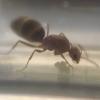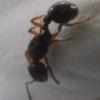1) Location: I found her in a parking lot, in south Florida. She was just walking down a parking bump looking for a place to hide
2)Date collected: 4/24/2018
3)Habitat of collection: Parking lot next to public building
4)Length: 3 - 4mm
5)Coloration, hue, pattern and texture: she is dark brown with light brown strips
6)Distinguishing characteristics: none
7-9) N/A




Sorry i don't have any better quality photo's



















